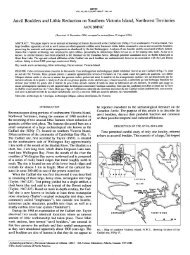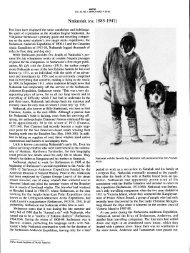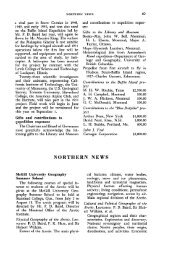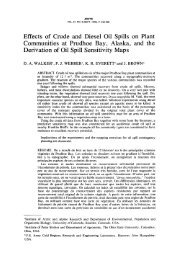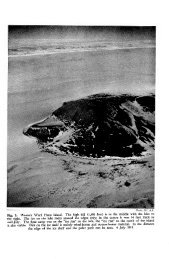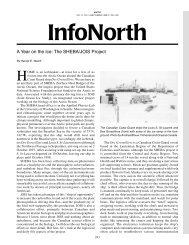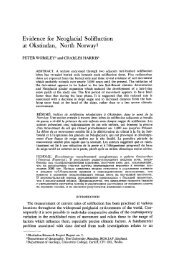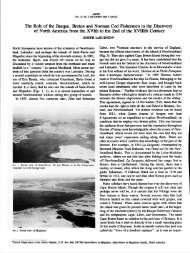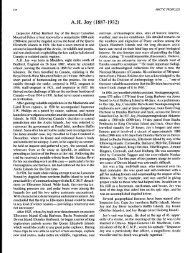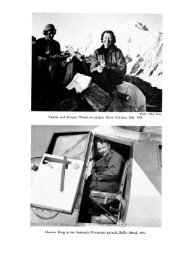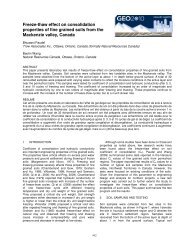Management by Totemization: Whale Symbolism and the ... - arctic
Management by Totemization: Whale Symbolism and the ... - arctic
Management by Totemization: Whale Symbolism and the ... - arctic
You also want an ePaper? Increase the reach of your titles
YUMPU automatically turns print PDFs into web optimized ePapers that Google loves.
ARCTIC<br />
VOL. 46, NO. 2 (JUNE 1993) P. 124-133<br />
<strong>Management</strong> <strong>by</strong> <strong>Totemization</strong>:<br />
<strong>Whale</strong> <strong>Symbolism</strong> <strong>and</strong> <strong>the</strong> Anti-Whaling<br />
ARNE KALLAND’<br />
(Received 18 November 1991; accepted in revised form 22 June 1992)<br />
Campaign<br />
ABSTRACT. The anti-whaling campaign has been with for us about two decades <strong>by</strong> now, <strong>and</strong> - not surprisingly - <strong>the</strong> arguments against whaling<br />
have changed during <strong>the</strong>se years. The ecological argument that <strong>the</strong> whales are endangered is losing ground as it becomes clear that <strong>the</strong> stocks of<br />
some species of whales can sustain regulated harvest. Therefore, during <strong>the</strong> last few years more <strong>and</strong> more people have argued against whaling on<br />
moral <strong>and</strong> ethical grounds. <strong>Whale</strong>s have come to hold a special place in <strong>the</strong> animal kingdom.<br />
Three related <strong>the</strong>mes are addressed in this paper. First, <strong>the</strong> process <strong>by</strong> which whales are turned into a symbol is analyzed. By combining characteristics<br />
found in a number of different whale species, a picture of a “super-whale” has emerged. Second, it is argued that whales have such potential as<br />
symbols because 1) whales are anomalous animals difficult to categorize, 2) <strong>the</strong>y live in salt water, which symbolizes <strong>the</strong> ultimate purity, 3) <strong>the</strong>y<br />
have a long history, <strong>and</strong> 4) <strong>the</strong>y have qualities that we would lie to see in our fellow human beings. It is argued that whales are turned into totems,<br />
thus dichotomizing mankind into “good guys” (protectors of whales) <strong>and</strong> “bad guys” (whalers). Finally, it is shown that <strong>by</strong> turning whales into<br />
totems <strong>and</strong> imposing an indefinite moratorium on whaling, <strong>the</strong> resource base of many coastal communities in nor<strong>the</strong>rn Norway has been narrowed<br />
significantly, which has serious implications for <strong>the</strong> viability of <strong>the</strong>se communities.<br />
Key words: whales, whaljng, management, protectionism, symbolism, totem, rhetoric, impact, nor<strong>the</strong>rn Norway<br />
RBSUMÉ. Les campagnes contre la chasse h la baleine existent depuis plus de 20 ans, et il n’est pas surprenant que les arguments aient change<br />
au cours des ann&. L’argument &logique voulant que les baleines soient menacks est en train de perdre du terrain car il devient Bvident que<br />
le stock de certaines es@s peut supporter une prise dglementk. Par con@uent, au cours des dernibres ann&s, de plus en plus de gens se sont<br />
oppos6s B la chasse B la baleine d’un point de vue moral et kthique. Les baleines en sont venues h occuper une place privilkgih dans le rbgne animal.<br />
Cet article aborde trois Mmes qui sont reli6s. En premier lieu, on analyse le processus par lequel les baleines sont transformks en symboles.<br />
De la combinaison des caractkristiques d’un certain nombre d’eswes diffkrentes est ressortie l’image d’une *super-baleine*. On soutient ensuite<br />
que le potentiel symbolique des baleines vient de ce qu’elles 1) sont des animaux sortant de l’ordinaire, difficiles h classer, 2) vivent dans l’eau<br />
sal&, qui symbolise la puret6 absolue, 3) ont une longue histoire, et 4) ont des qualit6s que l’on aimerait retrouver chez nos confrbres humains.<br />
On soutient que les baleines sont Crigks en totems, ce qui divise l’humanit6 en abons. (qui proegent les baleines) et en am6chants* (qui les chassent).<br />
On d6montre finalement que la transformation des baleines en totems et l’imposition d’un moratoire d’une dur& ind6terminke ont rauit de façon<br />
significative la base de ressources de nombreuses communaut6s dtibres de la Norvbge septentrionale, ce qui a de sBrieuses consequences pour la<br />
viabdit6 de ces communaut6s.<br />
Mots clks: baleines, chasse h la baleine, gestion, protectionnisme, symbolisme, totem, rhbtorique, impact, Norvbge septentrionale<br />
Traduit pour le journal par N6sida Loyer.<br />
A large proportion of <strong>the</strong> inhabitants of <strong>the</strong> nor<strong>the</strong>rn regions The ecological argument that <strong>the</strong> whales are endangered is<br />
still depends on renewable natural resources - such as fish, losing ground, however, <strong>and</strong> <strong>the</strong> Scientific Committee of <strong>the</strong><br />
marine <strong>and</strong> terrestial mammals, plants, <strong>and</strong> birds - for <strong>the</strong>ir Intemational Whaling Commission (WC) <strong>and</strong> <strong>the</strong> U. S. Marine<br />
livelihood. The availability of many of <strong>the</strong>se resources is highly Mammal Commission have made it clear that some of 75-odd <strong>the</strong><br />
unpredictable in that <strong>the</strong>y vary greatly between seasons <strong>and</strong> from species of whales can sustain regulated harvest (letter dated<br />
one year to <strong>the</strong> next, forcing people to exploit several resources 5 December 1991 from <strong>the</strong> executive director of <strong>the</strong> Marine<br />
in order to make sustainable communities. Defining a niche as Mammal Commission, John R. Twiss, to <strong>the</strong> U.S. commissioner<br />
“<strong>the</strong> place of a group in <strong>the</strong> total environment, its relation to to <strong>the</strong> IWC, John A. Knauss). Never<strong>the</strong>less, <strong>the</strong> anti-whaling<br />
resources <strong>and</strong> competitors’’ (Barth, 1969:363), it can be argued campaign continues unabated, albeit with somewhat new<br />
that whalers in Alaska (Alaska Consultants Inc., 1984), Canada arguments. “Now is an appropriate time to face <strong>and</strong> discuss<br />
(Wenzel, 1991), Greenl<strong>and</strong> (Kapel <strong>and</strong> Petersen, 1982), Icel<strong>and</strong> <strong>the</strong> moral <strong>and</strong> ethical issues involved in <strong>the</strong> commercial<br />
(Piilsson, 1992), <strong>and</strong> Norway (ISG, 1992) typically exploit harvesting of whales,” says Robbins Barstow (1989:lO;<br />
multispecies niches, which give people flexibility in <strong>the</strong>ir emphases added), director of Cetacean Society International.<br />
adaptations to <strong>the</strong> environment.<br />
This is echoed <strong>by</strong>, among o<strong>the</strong>rs, <strong>the</strong> U.S. commissioner to <strong>the</strong><br />
Today this flexibility is challenged from many quarters. An WC, John Knauss, who in an interview stated that he <strong>the</strong>reincreasing<br />
number of people <strong>and</strong> institutions claim access to <strong>the</strong> after would have to oppose whaling on ethical grounds since<br />
Arctic, leading to pollution <strong>and</strong> o<strong>the</strong>r disturbances that have scientific evidence now indicates that some stocks can be hunted<br />
long-lasting effects on this fragile environment. This has, among under proper protective measures (Marine Mammal News,<br />
o<strong>the</strong>r things, caused depletion of marine resources, with restric- 1991). Scheffer (1991), a former member of <strong>the</strong> U.S. Marine<br />
tions imposed on access as a result. Although this leads to a Mammal Commission, has tried (partly tautologically) to give<br />
loss of flexibility, <strong>and</strong> thus greater vulnerability in <strong>the</strong> future, four reasons why we should care about whales: because whales<br />
such restrictions are in general accepted if people used to figure as icons or totems in <strong>the</strong> animal liberation movement;<br />
harvesting <strong>the</strong>se resources are convinced that <strong>the</strong> restrictions because <strong>the</strong>y are marvellous <strong>and</strong> mysterious; because <strong>the</strong>y are<br />
are ecologically sound. But whalers have never accepted <strong>the</strong> beautiful; <strong>and</strong> because <strong>the</strong>y enrich our folklore.<br />
anti-whalers’ argument that a total moratorium on all Although such sentiments are <strong>by</strong> no means new to <strong>the</strong><br />
commercial whaling had to be imposed because of over- environmental movement <strong>and</strong> have been particularly strong in<br />
exploitation of <strong>the</strong> whale stocks.<br />
Greenpeace (Herscovici, 1985; Brown <strong>and</strong> May, 1989; Pearse,<br />
‘Nordic Institute of Asian Studies, 84 Njalsgade, DK-2300 Copenhagen S, Denmark<br />
@The Arctic Institute of North America
MANAGEMENT BY TOTEMIZATION / 125<br />
1991), organizations that hi<strong>the</strong>rto have claimed to be concerned Biologically Special<br />
solely with ecological issues have also come to question <strong>the</strong><br />
ethics of harvesting whales. World Wide Fund for Nature (alias First, says Barstow, <strong>the</strong> whales are biologically special. The<br />
World Wildlife Fund, WWF), for example, stated in a press blue whale is <strong>the</strong> largest animal on earth, which is of course<br />
release before <strong>the</strong> opening of <strong>the</strong> 43rd annual meeting of <strong>the</strong> true, but <strong>the</strong> cetacean family also includes <strong>the</strong> small common<br />
IWC in Reykjavik in 1991 that “as more <strong>and</strong> more people porpoise, which measures less than 2 m. Barstow continues <strong>by</strong><br />
worldwide become aware of <strong>the</strong> remarkable qualities of whales, stating that <strong>the</strong> sperm whale has “<strong>by</strong> far <strong>the</strong> largest brain of<br />
<strong>the</strong>re is increasing doubt about <strong>the</strong> ethics of killing whales for any creature ever to have lived on our planet” (1991 :6) but fails<br />
commercial profit even if it could be guaranteed to be both to say that <strong>the</strong> brain is only slightly bigger than that of an Asiatic<br />
sustainable <strong>and</strong> humane.” WWF leaders have repeatedly elephant <strong>and</strong> constitutes only 0.021% of <strong>the</strong> animal’s body<br />
argued that commercial whaling is unethical. In a letter dated weight, as compared to 0.08% for a cow, 0.15% for <strong>the</strong><br />
23 January 1.992 to <strong>the</strong> Swedish ministers of environment <strong>and</strong> elephant, <strong>and</strong> 2.1 % for human beings (Freeman, 1990:112).<br />
agriculture, for example, <strong>the</strong> general-secretary of WWF-Sweden, Then he postulates that several species have more complex<br />
Jens Wahlstedt, stressed that whales have such great symbolic brains than human beings. O<strong>the</strong>rs have carried this argument<br />
value that a resumption of commercial whaling is unacceptable. fur<strong>the</strong>r, such as <strong>the</strong> former leader of Greenpeace’s anti-whaling<br />
There can be little doubt that influential leaders within <strong>the</strong> campaign, Mikael Gylling-Nielsen, who in an article entitled<br />
WWF <strong>and</strong> Greenpeace have placed <strong>the</strong>mselves among <strong>the</strong> “Havets mennesker” (“The humans of <strong>the</strong> oceans”) claims that<br />
animal rights advocates. In so doing, <strong>the</strong>y blur a distinction that “it is generally accepted that <strong>the</strong> structures of dolphin <strong>and</strong> human<br />
should prevail between two concepts. Environmentalists are brains, including size, <strong>the</strong> number <strong>and</strong> area of convolutions of<br />
concerned about environments as ecological sysfem <strong>and</strong> <strong>the</strong>re- <strong>the</strong> brain, <strong>and</strong> cellular organization, are identical” (Gyllingfore<br />
work to secure habitat <strong>and</strong> species diversity. A species’ Nielsen, 1987: 11).<br />
survival is, of course, an ecological issue, but not so <strong>the</strong> The cetaceans’ apparent ability to communicate is also taken<br />
well-being of individual animals (Lynge, 1990:47). The latter as an indication of <strong>the</strong>ir intelligence. The humpback whale’s<br />
is <strong>the</strong> concern of animal rights advocates who are against killing rich repertoire of sounds inspired Heathcote Williams to write<br />
of animals per se. But unlike <strong>the</strong> mainstream animal rights <strong>the</strong> following poem about whale songs <strong>and</strong> oral traditions<br />
proponents, most of <strong>the</strong> anti-whalers have few misgivings as allegedly going back 50 million years (Williams, 1988:17):<br />
to lethal consumption of domesticated animals, such as calves,<br />
pigs, lambs, turkeys, <strong>and</strong> chickens. To <strong>the</strong>m whales are unique.<br />
It has been argued that <strong>the</strong>re a growing is tendency in modem<br />
society to treat certain animals as totems (Menninger, 1951),<br />
which might be caused <strong>by</strong> modem man’s need to compensate<br />
Webs of elegant cetacean music stretch around <strong>the</strong> globe;<br />
Lyrical litanies on <strong>the</strong> bio-radio<br />
That draw on an oral tradition of submarine songs<br />
From a living memory bank, founded fifty million years ago.<br />
Ano<strong>the</strong>r aspect that fascinates many is <strong>the</strong> ability of at least<br />
for being alienated from nature or, as Menninger points out, some species for echo-location <strong>and</strong> scanning <strong>by</strong> ultrasonic<br />
<strong>by</strong> a person’s inability to satisfy social <strong>and</strong> emotional, including waves. Here some authors’ imaginations appear to have no<br />
sexual, cravings in company with fellow human beings. My limits. “When we human beings say that we feel fine although<br />
objective is, however, not to analyze <strong>the</strong> psychological needs in fact we do not,” writes Johannsen (1990:45) in his book<br />
behind our totems, but ra<strong>the</strong>r to analyze why some animals - Hvalenzes verden, published in cooperation with WWF-Denmark,<br />
e.g., whales - make better totems than o<strong>the</strong>rs for many environ- “<strong>the</strong> dolphins can perhaps see, or ra<strong>the</strong>r hear, whe<strong>the</strong>r ano<strong>the</strong>r<br />
mentalists <strong>and</strong> animal rights advocates. How are whales turned dolphin is really ill or healthy. ” Abbey (1990:41) writes in<br />
into a powerful symbol - a “super-whale,” which in several similar vein in his novel The Last whales. When a group of<br />
ways resembles a totem - <strong>and</strong> why have whales such great dolphins surrounded a male blue whale who was not feeling<br />
potential as a symbol to an ever-increasing number of people, healthy, one of <strong>the</strong>m scanned <strong>the</strong> whale <strong>and</strong> diagnosed it as<br />
particularly in Western urban societies? What is unique about having worms in its kidneys.<br />
whales? A second objective is to explore <strong>the</strong> implications of Frequently claims for <strong>the</strong> high intelligence of whales are<br />
turning whales into totems. More precisely, <strong>the</strong> paper will wrapped in a mystical language rendering <strong>the</strong> meaning almost<br />
explore how, in <strong>the</strong> zeal to protect this totem animal against incomprehensible. Quoting Lilly’s (1967) pioneering work in<br />
all lethal “consumptive use,” whalers <strong>and</strong> eaters of whale meat man-dolphin communication, D’Amato <strong>and</strong> Chopra<br />
are being depicted as savages or reckless capitalists, thus (1991:21-22) have argued for “whale rights” based on <strong>the</strong><br />
dichotomizing mankind into “good” people (whale lovers) <strong>and</strong> whale’s unique intelligence:<br />
“bad” people (whalers, whale eaters). Or to put <strong>the</strong> causality<br />
<strong>the</strong> o<strong>the</strong>r way around: how, <strong>by</strong> totemizing <strong>the</strong> prey of whalers, If a sperm whale, for example, wants to see-hear-feel any past<br />
<strong>the</strong> whale protectionists can construct an image of <strong>the</strong>mselves<br />
experience, his huge computer Lbrain] can reprogram it <strong>and</strong> run<br />
it off again. His huge computer gives him a reliving, as if with<br />
as caring <strong>and</strong> peaceful <strong>by</strong> portraying <strong>the</strong> whalers as greedy<br />
a three-dimensional sound-color-taste-emotion re-experiencing<br />
<strong>and</strong> barbarous. Finally, a case study from nor<strong>the</strong>rn Norway motion picture.<br />
will throw light on <strong>the</strong> social <strong>and</strong> cultural costs inflicted upon<br />
local communities <strong>by</strong> managing natural resources through This led D’Amato <strong>and</strong> Chopra (199 1 :2 1) to claim that <strong>the</strong>re<br />
totemization.<br />
is no need for writers of science fiction to speculate about<br />
higher than human intelligence in outer space, since <strong>the</strong>re might<br />
THE CREATION OF A “SUPERWHALE’<br />
already exist such forms of life on eirth, e.g., <strong>the</strong> whales. By<br />
taking Lilly as <strong>the</strong>ir source <strong>and</strong> ignoring all scientists of a<br />
<strong>Whale</strong>s are, according to Barstow (1991), special in five<br />
different ways: biologically, ecologically, culturally, politically,<br />
<strong>and</strong> symbolically.<br />
different opinion, D’Amato <strong>and</strong> Chopra forget that this<br />
presumed high intelligence of whales is sheer speculation ra<strong>the</strong>r<br />
than established fact.
126 / A. KALLAND<br />
It is <strong>by</strong> no means generally accepted that <strong>the</strong> dolphin <strong>and</strong> such as <strong>the</strong> blue <strong>and</strong> bowhead whales, are endangered does not<br />
human brains are identical, however. On <strong>the</strong> contrary, many justify a total moratorium on all killing of all whales. After all,<br />
scientists have questioned <strong>the</strong> great intelligence of dolphins <strong>the</strong> fact that <strong>the</strong> white-tailed eagle seems be to endangered does<br />
(Prescott, 1981; Pryor, 1981), while o<strong>the</strong>rs have argued that not mean that we should protect all birds, chickens included.<br />
dolphin brains are more similar to brains of hoofed animals When WWF-Denmark ran its “SOS Save <strong>the</strong> <strong>Whale</strong>”<br />
(Bryden <strong>and</strong> Cockeron, 1989:161). Klinowska (1988:46), who campaign, its leaders must have been fully aware that <strong>the</strong><br />
is a special adviser to <strong>the</strong> World Conservation Union (IUCN), organization deceived large groups of people in an effort to<br />
concludes that <strong>the</strong> dolphin’s brain has hardly evolved since <strong>the</strong> increase its income. Barstow is more honest when he confesses<br />
cetaceans left l<strong>and</strong> for a life in <strong>the</strong> Oceans <strong>and</strong> has been stuck that scientific data show that “at least some species of whales<br />
at <strong>the</strong> paralimbic-parinsular stage, which is <strong>the</strong> most primitive could easily sustain a resumed, strictly-regulated harvest,<br />
stage in l<strong>and</strong> mammals. Thus dolphin brains are in structure without threatening species survival” (Barstow, 1989: 10). It is<br />
more similar to those of hedgehogs <strong>and</strong> bats than those of this fact that has forced him to take up moral <strong>and</strong> ethical issues<br />
primates.<br />
involved in <strong>the</strong> commercial harvesting of whales.<br />
The whales’ ability to communicate, moreover, does not<br />
necessarily imply high intelligence, as <strong>the</strong> rich repertoire of Culturally, Politically, <strong>and</strong> Symbolically Special<br />
signals among <strong>the</strong> honey bees testifies. The echo-location is<br />
obviously a device cetaceans use to navigate under water <strong>and</strong><br />
To Barstow whales are culturally unique, not only because<br />
is a part of <strong>the</strong>ir genetic heritage, as it is among bats. That “<strong>the</strong><br />
whales, like <strong>the</strong> “friendly” gray whales, allegedly have a greater<br />
whales invented ultrasonic scanning” (italics added) millions<br />
capacity than any o<strong>the</strong>r animal to enrich our lives through<br />
of years before we started to use <strong>the</strong> technology in our hospitals,<br />
peaceful contact, but also because “<strong>the</strong>y are supremely photoas<br />
claimed <strong>by</strong> Johannsen (1990:45), falls on its own absurdity.<br />
genic,” <strong>the</strong>y have special aes<strong>the</strong>tic qualities, <strong>and</strong> <strong>the</strong>y play an<br />
important role in education. Moreover, whales appear to carry<br />
Ecologically Special<br />
no grudges against men despite <strong>the</strong> centuries of <strong>the</strong>ir being<br />
victimized <strong>by</strong> human predation (Barstow, 1991:6).<br />
Barstow (1991 :6) is also of <strong>the</strong> opinion that whales are <strong>Whale</strong>s have made a great impact in popular culture, <strong>and</strong> <strong>the</strong><br />
ecologically special. It is stressed that whales probably are at value of “non-consumptive use” of cetaceans today far exceeds<br />
least 25 million years old (1991:6), but o<strong>the</strong>r animals have <strong>the</strong> value of whaling (Kall<strong>and</strong>, 1992). A number of books,<br />
existed even longer without being <strong>the</strong> object of <strong>the</strong> same magazines, television <strong>and</strong> radio broadcastings, motion pictures,<br />
veneration. Fur<strong>the</strong>rmore, Barstow claims that whales are at <strong>the</strong> records, paintings <strong>and</strong> o<strong>the</strong>r art objects, whale-watching tours,<br />
top of <strong>the</strong> food chain. The baleen whales are <strong>the</strong> largest eaters dolphinariums, <strong>and</strong> computer games cater to <strong>the</strong> consumers.<br />
of zooplankton <strong>and</strong> <strong>the</strong> killer whale is <strong>the</strong> largest non-human Dolphins, in particular, stir people’s imaginations <strong>and</strong> have<br />
predator. This is hardly controversial, nor is <strong>the</strong> claim that we become popular in science fiction literature, for example.<br />
all depend on oxygen in <strong>the</strong> atmosphere. But his assertion that Politically <strong>the</strong> whales are regarded as special because <strong>the</strong>y<br />
“<strong>the</strong> proper balance in <strong>the</strong> amount of oxygen in <strong>the</strong> earth’s do not know national borders, which is one reason why it is<br />
atmosphere produced from <strong>the</strong> plankton . . . is kept in check claimed that whales must be managed <strong>by</strong> international bodies.<br />
most critically <strong>by</strong> whale consumption” (Barstow, 1989:13) is But this is not unique to whales <strong>and</strong> is equally valid to some<br />
not substantiated in any way.<br />
fish <strong>and</strong> birds, which may travel much longer distances than<br />
The leap from this kind of “ecological” argument to <strong>the</strong> too<strong>the</strong>d whales, which, with <strong>the</strong> exception of adult sperm<br />
following letter written <strong>by</strong> a British woman to <strong>the</strong> Faroese whales, usually do not migrate widely (Watson, 198551).<br />
government is not that great (quoted in full in S<strong>and</strong>erson, If whales are culturally <strong>and</strong> politically unique, this is so not<br />
1990: 199):<br />
because of some unique qualities in whales per se, but as a result<br />
The Slaughter in <strong>the</strong> Faroes of <strong>the</strong> dolphins <strong>and</strong> whales is causing of how we perceive whales. In o<strong>the</strong>r words, <strong>the</strong> perceived<br />
untold damage to <strong>the</strong> ozone layer. The special sound <strong>the</strong> cultural <strong>and</strong> political uniqueness of whales is an effect of human<br />
dolphins <strong>and</strong> whales emit holds <strong>the</strong> ozone layer toge<strong>the</strong>r. It is activities <strong>and</strong> thus a cultural product, created mainly <strong>by</strong> urban<br />
<strong>the</strong> utmost importance to stop this terrible slaughtering of <strong>the</strong>se people in <strong>the</strong> Western world under certain economic <strong>and</strong><br />
wonderful creatures, so many of which are far more evolved political conditions. What is culturally <strong>and</strong> politically unique<br />
than man. . . .<br />
about whales is no more than an invention of <strong>the</strong> human - or<br />
PS: The dolphins are <strong>the</strong> guardians of this planet.<br />
certain humans’ .- mind. The same can be said about <strong>the</strong><br />
Every species has a special role to play in <strong>the</strong> ecosystem, symbolic uniqueness of whales. When Barstow points out that<br />
Homo sapiens included. In a way we are all unique. At <strong>the</strong> same whales have come to symbolize concern for all life in this<br />
time it is difficult, <strong>and</strong> dangerous, to argue that certain mammals<br />
are ecologically more important than o<strong>the</strong>rs. On what criteria<br />
should we base such a ranking among living species?<br />
Many people believe that whales are endangered. But that<br />
most marine mammal stocks are abundant <strong>and</strong> only a few of<br />
<strong>the</strong> more than 75 species of cetaceans are endangered (Aron,<br />
1988) is concealed <strong>by</strong> whale protectionists. That <strong>the</strong> minke<br />
whale - which Greenl<strong>and</strong>, Icel<strong>and</strong>, Japan, <strong>and</strong> Norway want<br />
to harvest - is not endangered <strong>and</strong> might be more abundant<br />
in <strong>the</strong> Ant<strong>arctic</strong> than ever (Gull<strong>and</strong>, 1988:44) is not mentioned.<br />
Nor is <strong>the</strong> fact that <strong>the</strong>re are, according to American estimates<br />
(Aron, 1988: 104), about 2 million sperm whales even though<br />
<strong>the</strong>y are on <strong>the</strong> list of “endangered species.” That a few species,<br />
“water planet” (1991:7), this fact tells us more about human<br />
society <strong>and</strong> culture than about whales.<br />
In summary, we are told that <strong>the</strong> whale is <strong>the</strong> largest animal<br />
on earth (this applies to <strong>the</strong> blue whale), that <strong>the</strong> whale has <strong>the</strong><br />
largest brain on earth (<strong>the</strong> sperm whale), that <strong>the</strong> whale has a<br />
large brain to body weight ratio (<strong>the</strong> bottlenose dolphin), that<br />
<strong>the</strong> whale has a pleasant <strong>and</strong> varied song (<strong>the</strong> humpback), that<br />
<strong>the</strong> whale is friendly (<strong>the</strong> gray whale), that <strong>the</strong> whale is<br />
endangered (<strong>the</strong> bowhead <strong>and</strong> blue whales), <strong>and</strong> so on. By<br />
talking about <strong>the</strong> whale, an image of a single whale possessing<br />
all of <strong>the</strong>se traits emerges. But such a creature does not exist.<br />
It is a mythic creation - a “super-whale,” which has come<br />
to represent all species of cetaceans.
MANAGEMENT BY “I’EMIZATION / 127<br />
WHY WHALES?<br />
around us, mammals usually have four legs <strong>and</strong> walk on l<strong>and</strong>.<br />
Why do so many people <strong>and</strong> organizations spend so much But whales - <strong>and</strong> seals - live in <strong>the</strong> sea <strong>and</strong> not on l<strong>and</strong>, <strong>and</strong><br />
time <strong>and</strong> energy on creating this image, <strong>and</strong> why does this image <strong>the</strong>y have fins <strong>and</strong> not legs. Unlike fish, <strong>the</strong>ir tails are horizontal,<br />
of <strong>the</strong> super-whale have such an appeal <strong>and</strong> sell so well? Why ra<strong>the</strong>r than vertical, <strong>and</strong> <strong>the</strong>y have no scales. <strong>Whale</strong>s form an<br />
are marine mammals offered better protection <strong>by</strong> U.S. laws than anomalous category of animals (Kall<strong>and</strong> <strong>and</strong> Moeran, 1992:5-6),<br />
any o<strong>the</strong>r species (Manning, 1989:220)? There are a number since <strong>the</strong>y do not fit into our simple categories of mammals <strong>and</strong><br />
of answers to <strong>the</strong>se questions, ranging from economy <strong>and</strong> fish. <strong>Whale</strong>s are “betwixt <strong>and</strong> between,” <strong>and</strong> it is, according<br />
politics to information management <strong>and</strong> psychology. to Douglas (1966), exactly those animals difficult to fit into our<br />
In <strong>the</strong> first place, <strong>the</strong>re are pragmatic reasons to jump on <strong>the</strong> cognitive maps that become <strong>the</strong> object of myths <strong>and</strong> taboos.<br />
anti-whaling - <strong>and</strong> anti-sealing - b<strong>and</strong>wagon. Of course, On <strong>the</strong> o<strong>the</strong>r h<strong>and</strong>, mythical creatures, such as mermaids,<br />
environmentalists as well as animal rights activists have learned trolls; <strong>and</strong> ninja turtles, also fall in this “betwixt <strong>and</strong> between”<br />
that whales <strong>and</strong> seals open people’s purses, <strong>and</strong> <strong>the</strong>y skillfully category, because <strong>by</strong> definition <strong>the</strong>y have traits found in various<br />
play up to this tendency (c$ <strong>the</strong> fake photograph of Brigitte species. Our mythical super-whale is even more “betwixt <strong>and</strong><br />
Bardot with a seal pup). Successes attract people to <strong>the</strong> cause, between” than its real cousin, in that animal rights people have<br />
<strong>and</strong> <strong>the</strong> odds of winning are important considerations when cleverly created an image of an animal that is large <strong>and</strong> smart<br />
selecting issues - not only because of <strong>the</strong> money this gives <strong>the</strong> <strong>and</strong> fond of music <strong>and</strong> friendly <strong>and</strong> caring <strong>and</strong> so on ad<br />
organizations, but also because a large number of members <strong>and</strong> in$nitum. The less we know about real whales, <strong>the</strong> more can<br />
supporters makes <strong>the</strong> organizations more able to function as be left to our imagination, <strong>and</strong> <strong>the</strong> more “betwixt <strong>and</strong> between”<br />
strong pressure groups. Harald Zindler, a Greenpeace leader <strong>the</strong> super-whale can be made.<br />
in Germany, called <strong>the</strong>mselves “strategische Opportunisten” Second, whales - <strong>and</strong> seals - move in salt water. We know<br />
(Schwarz, 1991: 105), while Steve Sawyer, international director very little about what is going on in <strong>the</strong> oceans, which turns<br />
of Greenpeace, has stated that <strong>the</strong> philosophy of <strong>the</strong> organiza- <strong>the</strong> sea into a good “issue” on which to focus (Kall<strong>and</strong> <strong>and</strong><br />
tion is very pragmatic: <strong>the</strong> leaders choose issues <strong>the</strong>y feel <strong>the</strong>y Moeran, 1992:7-8). Moreover, both salt <strong>and</strong> water are important<br />
are able to win (Pearse, 1991 :40). Victories are given top purifying agents <strong>and</strong> are used in religious rites throughout <strong>the</strong><br />
priority (Eyerman <strong>and</strong> Jamison, 1989:104), since victories, world. The ocean becomes <strong>the</strong> ultimate symbol of purity, of<br />
particularly if <strong>the</strong>y are won against apparently great odds, bring untouched nature, <strong>and</strong> thus st<strong>and</strong>s in sharp contrast to <strong>the</strong><br />
money <strong>and</strong> supporters. Hence, <strong>the</strong> organizations tend to polluted soil on which we l<strong>and</strong> mammals tread. It is we, who<br />
exaggerate crises <strong>and</strong> <strong>the</strong> strength of <strong>the</strong>ir adversaries. The move on l<strong>and</strong>, who pollute <strong>the</strong> pure sea. No wonder that when<br />
organizations typically urge sympathizers to donate more money <strong>the</strong> Danish chemical company Brfiste “bought” a sperm whale<br />
before <strong>the</strong> annual IWC meetings, when <strong>the</strong>y give <strong>the</strong> impression from <strong>the</strong> WWF in order to improve its green image - or<br />
that <strong>the</strong> present moratorium is in danger of being lifted. perhaps to expiate previous sins - <strong>the</strong> whale was called<br />
The whaling issue is also an ideal issue for national “Brfiste’s pioneer whale loves pure salt water” (Brbstes<br />
governments <strong>and</strong> polluting industries to support. Whaling being<br />
pionerhval elsker rent saltv<strong>and</strong>).<br />
of only marginal economic importance - <strong>and</strong> in most countries<br />
But salt water has o<strong>the</strong>r qualities, of course. We all started<br />
of no importance at all - this is a “safe” issue <strong>and</strong> <strong>the</strong>re is<br />
our lives in <strong>the</strong> uterus submerged this in kind of water, <strong>and</strong> salty<br />
hardly anything to lose <strong>by</strong> joining <strong>the</strong> crowd. The rewards in<br />
terms of “green images” are, on <strong>the</strong> o<strong>the</strong>r h<strong>and</strong>, substantial<br />
water is thus indispensable for our own existence. It has been<br />
(Rose,. 1989). The anti-whaling campaign, <strong>the</strong>refore, offers<br />
suggested that people’s attitudes to whales <strong>and</strong> seals are reflecgovernments<br />
<strong>and</strong> industries an opportunity to show <strong>the</strong>ir tions of an unconscious memory of, <strong>and</strong> yearning for, life in<br />
consideration for <strong>the</strong> environment, while <strong>the</strong> campaign has <strong>the</strong> mo<strong>the</strong>r’s womb (Grof, 1985:142; Lynge, 1990:60). But<br />
proved an excellent fund raiser for <strong>the</strong> environmental <strong>and</strong> animal despite having lived our first months in water, we are unable<br />
rights movements. Gull<strong>and</strong> (1988:45), an adviser to <strong>the</strong> IWC, to swim like a whale. Without technological aids such as diving<br />
has pointed out that “There may no longer be urgent reasons gear <strong>and</strong> submarines, we are confined to life on l<strong>and</strong>. Human<br />
of conservation for continued pressure to streng<strong>the</strong>n <strong>the</strong> control beings may harbour a feeling of envy toward whales, as <strong>the</strong>re<br />
of whaling, but <strong>the</strong>re are sound financial reasons for groups is a feeling of envy toward birds for being able to move freely<br />
that depend on public subscription to be seen to be active in in <strong>the</strong> skies.<br />
‘saving <strong>the</strong> whale.’ ” To summarize, <strong>the</strong> anti-whaling campaign The humpback whales, <strong>and</strong> to a certain extent some of <strong>the</strong><br />
attracts organizations for <strong>the</strong> same reasons as <strong>the</strong> anti-sealing dolphins, bridge <strong>the</strong> realms of sea <strong>and</strong> air, thus making <strong>the</strong>m<br />
campaign, i.e., <strong>the</strong> potential supporters are relatively isolated doubly fascinating. The humpback is able to jump out of water,<br />
from <strong>the</strong> negative effects of <strong>the</strong> campaign <strong>and</strong> <strong>the</strong> goal of <strong>the</strong> waving its long flippers like wings. Greenpeace’s inflatable<br />
campaign appears to be relatively inexpensive (Allen, 1979:424). humpback has been flown in anti-whaling demonstrations around<br />
The question remains, however, why people attach so much <strong>the</strong> world, while countless humpback whales fly through <strong>the</strong><br />
importance to whales <strong>and</strong> <strong>the</strong>refore more readily donate money air in Japanese advertisements, often carrying children on <strong>the</strong>ir<br />
in order to “save” <strong>the</strong>m ra<strong>the</strong>r than endangered bats, for backs. The flying whale is also a topic in Williams’s poems,<br />
example. Although preferential attitudes, which are said to exist<br />
<strong>and</strong> in one he links <strong>the</strong> unrestricted lives of whales, birds, <strong>and</strong><br />
toward large (Kellert, 1988) <strong>and</strong> juvenile-looking animals<br />
(Lorentz, 1981) in modern society, may help turn large whales<br />
humans in <strong>the</strong> womb, thus giving credence to <strong>the</strong> claim that<br />
<strong>and</strong> seal pups into likely c<strong>and</strong>idates for totemic treatment, <strong>the</strong>re we yearn for life in <strong>the</strong> mo<strong>the</strong>r’s womb (Williams, 1988:12):<br />
are undoubtedly o<strong>the</strong>r factors working in <strong>the</strong> same direction. <strong>Whale</strong>s play, in an amniotic paradise.<br />
The Symbolic Power of <strong>Whale</strong>s <strong>and</strong> Salt Water<br />
Their light minds shaped <strong>by</strong> buoyancy, unrestricted <strong>by</strong> gravity,<br />
Somersaulting,<br />
First, whales are animals to which symbolic significance can Like angels, or birds;<br />
easily be ascribed. In <strong>the</strong> way in which we categorize <strong>the</strong> world Like our own lives, in <strong>the</strong> womb.
128 / A. KALLAND<br />
Since Ancient Times<br />
<strong>the</strong>se skills in <strong>the</strong> first place, because, according to Watson<br />
(1985:48), “our best-developed areas are those which deal with<br />
Third, as many of <strong>the</strong> protectionists never fail to point out, <strong>the</strong> elaboration of motor skills made possible <strong>by</strong> our h<strong>and</strong>s, while<br />
<strong>the</strong> cetacean brain developed long before <strong>the</strong> development of cetaceans seem to concentrate on areas of social perception.<br />
human beings (Barstow, 1991 :6) or, to use <strong>the</strong> words of Watson, Dolphins show marked development of those parts of <strong>the</strong> brain<br />
a member of Seychelle’s delegation to <strong>the</strong> IWC <strong>and</strong> a writer responsible for orientation, social skill, emotional self-control<br />
of para-psychology: “When men were insignificant nocturnal <strong>and</strong> perhaps even humour. ”<br />
insectivores” (Watson, 1985:48).<br />
Closely related to this is <strong>the</strong> question of caring for each o<strong>the</strong>r.<br />
With this long time perspective in mind, Lilly (quoted in While commercialization has penetrated most human relations,<br />
Linehan, 1979539) wants to find out whe<strong>the</strong>r dolphins have whales are depicted as <strong>the</strong> guardians of old values. The whales<br />
sagas <strong>and</strong> tell each o<strong>the</strong>r stories. Although it will, according allegedly care for <strong>the</strong> sick <strong>and</strong> dying, while people in <strong>the</strong><br />
to Lilly, take a lot of work before we can underst<strong>and</strong> <strong>the</strong>ir urbanized Western world pay hospitals <strong>and</strong> old people’s homes<br />
stories, such trouble might well be justified if it is true - as to take care of aging relatives, thus removing <strong>the</strong> sick <strong>and</strong> dying<br />
Lilly wants us to believe - that dolphins administer knowledge from sight. Ours is a death-denying society (Lawrence,<br />
that has been accumulated through an oral tradition more than 1986:53). Moreover, <strong>the</strong> super-whales take care of each o<strong>the</strong>r’s<br />
25 million years old. Such communication must be particularly calves. They ba<strong>by</strong>sit <strong>and</strong> run nurseries ‘(Watson, 1985:41),<br />
rewarding for geologists, palaeontologists, <strong>and</strong> historians who without charging anything for <strong>the</strong>se services. Not only do <strong>the</strong>y<br />
here might have a large potential store of knowledge. care for <strong>the</strong>ir own kind, time <strong>and</strong> time again tales of whales<br />
With this capacity for storytelling, it is no surprise to find rescuing humans are told. Men <strong>and</strong> women might also have<br />
that dolphins are supposed to have a rich <strong>and</strong> ancient culture behaved nobly, but that was in <strong>the</strong> past. Today money rules,<br />
<strong>and</strong> that <strong>the</strong>y “represent <strong>the</strong> closest approach to civilization, <strong>and</strong> urbanites carry with <strong>the</strong>m a nagging bad conscience, a bad<br />
not as defined in terms of machine or technology, but as realized conscience for not taking care of aging parents <strong>and</strong> for not gi<br />
among all intelligent beings, cetacean or human, where commu- children <strong>the</strong> attention <strong>the</strong>y need.<br />
nication <strong>and</strong> social bonds transcended <strong>the</strong> mere exigencies of Whe<strong>the</strong>r we have lost our social skills through rapid social<br />
life” (Abbey, 1990:80). Composing <strong>and</strong> playing music are also change, or whe<strong>the</strong>r we have never been very clever at h<strong>and</strong>lin<br />
cultural activities, <strong>and</strong> Johannsen (1990:83) claims that “<strong>the</strong> social relations, as implied <strong>by</strong> Watson (1985:48), <strong>the</strong> message<br />
humpbacks have certainly composed for millenia, before <strong>the</strong> is <strong>the</strong> same: we are in <strong>the</strong>se respects inferior to whales. <strong>Whale</strong>s<br />
first stone age man even got <strong>the</strong> idea of beating two bones are endowed with all <strong>the</strong> qualities we would like to see in our<br />
in rhythm. ”<br />
fellow men - kind, caring, playful. We have something to<br />
One may wonder why it is so important to stress that whales learn, <strong>and</strong> whales are <strong>the</strong>refore used for didactic purposes, just<br />
have lived on this planet for millions of years. Although as ‘‘good’’ birds have been used to give children bourgeois<br />
Klinowska (1988:46) has pointed out that cetacean brains have values (Liifgren, 1985). The whales, <strong>and</strong> “nice” birds, have<br />
hardly developed since <strong>the</strong> animals left shore for a life in <strong>the</strong> become models for us to emulate, <strong>and</strong> people do not eat <strong>the</strong>ir<br />
oceans, many whale protectionists argue that cetaceans have had teachers <strong>and</strong> models, at least not in <strong>the</strong> Western urban world.<br />
more time than man to evolve into intelligent creatures. While <strong>Whale</strong> meat has to become taboo, <strong>and</strong> eating it becomes a<br />
some authors are satisfied <strong>by</strong> claiming a 25- to 30-million-year barbarous act close to cannibalism. <strong>Whale</strong>s are taking on <strong>the</strong><br />
history for whales, o<strong>the</strong>rs write 50 (Williams, 1988: 17) or even characteristics of a totem.<br />
70 million years (WWF-Denmark, 1990). The antiquity of<br />
cetaceans seems to place whales above humans. They are more<br />
advanced than we are, <strong>the</strong>y are our teachers <strong>and</strong> may have more<br />
THE WHALE AS TOTEM<br />
to teach us than we have to teach <strong>the</strong>m (Lilly, 1961, quoted<br />
in Williams, 1988:113).<br />
The long history of whales also seems to give <strong>the</strong>m some<br />
unique rights to <strong>the</strong> oceans. Barstow (1991:6) writes that human<br />
Levi-Strauss (1966:37) has pointed out that “The beings<br />
which native thought endows with significance are seen as<br />
exhibiting a certain affinity with man. ” The super-whale has<br />
this affinity with men. It is our counterpart in <strong>the</strong> sea; it is <strong>the</strong><br />
beings have intruded into <strong>the</strong> territory of whales. The whales “human of <strong>the</strong> oceans.” It has qualities we would like to see<br />
thus emerge as <strong>the</strong> “aborigines” of <strong>the</strong> sea, leading ultimately in humans. In fact, according to Barstow (1989: 13), whales have<br />
to <strong>the</strong> premise of closing <strong>the</strong> oceans for many human activities a unique affinity for human beings. They love us <strong>and</strong> like to<br />
in <strong>the</strong> same way as aboriginal l<strong>and</strong>s are being closed to certain<br />
activities of white people.<br />
Lost Paradise<br />
entertain us, thus enriching our lives, but allegedly we can also<br />
enrich <strong>the</strong>irs (Barstow, 199 1 : 7).<br />
Discussing <strong>the</strong> relationship between man <strong>and</strong> his totem animal,<br />
Durkheim (1976: 139) makes <strong>the</strong> important point that this<br />
While <strong>the</strong> whales have lived in peaceful coexistence with <strong>the</strong>ir relationship is not that of a believer towards his god, but ra<strong>the</strong>r<br />
surroundings for 25 million years or more - or so whale one between two beings on <strong>the</strong> same level, between equals. The<br />
protectionists would have us believe - human beings have whales are claimed to be our equal, if not our superior. They<br />
played havoc on <strong>the</strong> earth <strong>and</strong> have lost <strong>the</strong>ir paradise after only mate “face to face, like man” (Williams, 1988:41), <strong>and</strong> whale<br />
a fraction of that time. Rapid urbanization has been seen as songs are carried toge<strong>the</strong>r with those of humans on Voyager Z<br />
leading to alienation <strong>and</strong> loss of purpose in life, to collapse of <strong>and</strong> ZZ through space. We are told that whales are at least as<br />
social networks, to soaring crime <strong>and</strong> divorce rates, <strong>and</strong> to <strong>the</strong> intelligent as we are, <strong>the</strong>y are more skilled in h<strong>and</strong>ling social<br />
young increasingly turning to drugs. Our social skills have been relations, <strong>the</strong>y deserve “whale rights,” <strong>and</strong> <strong>the</strong>re are talks about<br />
undermined. In much of <strong>the</strong> argument about <strong>the</strong> peculiarities “whalekind” as a counterpart to mankind. But <strong>the</strong> whale, or<br />
of whales we are presented precisely with <strong>the</strong> qualities that urban ra<strong>the</strong>r <strong>the</strong> super-whale, has taken on o<strong>the</strong>r characteristics of <strong>the</strong><br />
men <strong>and</strong> women seem to have lost. Or perhaps we never had totem as well.
Often, but not always, a group of people regard <strong>the</strong>ir totem<br />
as <strong>the</strong>ir ancestor. Few people claim that <strong>the</strong> whales are our<br />
ancestors, but <strong>by</strong> stressing <strong>the</strong> antiquity of whales <strong>and</strong> <strong>by</strong><br />
claiming that whales might be placed on a higher level than<br />
Homo sapiens on <strong>the</strong> evolutionary pyramid (<strong>by</strong> being a more<br />
ancient species, more intelligent, more apt at h<strong>and</strong>ling social<br />
affairs, etc .) , it can be argued that <strong>the</strong>y have come to play <strong>the</strong><br />
role of pseudo-ancestors. Moreover, a totem is frequently<br />
regarded as “<strong>the</strong> guardian spirit <strong>and</strong> helper” (Freud, 1960:2),<br />
<strong>and</strong> <strong>the</strong> many stories of whales, particularly dolphins, rescuing<br />
people at sea clearly testify to this ability among cetaceans. It<br />
is also claimed that swimming with dolphins is a <strong>the</strong>rapy for<br />
MANAGEMENT BY TOTEMIZATION / 129<br />
Moreover, <strong>the</strong> IWC meetings make it possible to bring <strong>the</strong><br />
whaling issue to <strong>the</strong> news headlines once a year.<br />
There is also whale-watching tourism, which has grown into<br />
a multi-milliondollar industry <strong>and</strong> which opens <strong>the</strong> whale rituals<br />
to a larger audience than spectacular actions at sea or IWC<br />
meetings can do. Here affluent people can observe whales<br />
firsth<strong>and</strong>. Not. only can <strong>the</strong>y “save” whales, but <strong>the</strong>y can<br />
“meet” <strong>the</strong>m, “engage” <strong>the</strong>m, <strong>and</strong> even “touch” <strong>the</strong>m. For<br />
<strong>the</strong>m, as for <strong>the</strong> writer of <strong>the</strong> history of Greenpeace, <strong>the</strong>re<br />
can be a “transcendent element lying at <strong>the</strong> center of <strong>the</strong><br />
undertaking.” They, too, can be said to be in search of <strong>the</strong>ir<br />
“Holy Grail” (Hunter, 1979:150).<br />
h<strong>and</strong>icapped children <strong>and</strong> for people suffering from depression<br />
Bad Guys <strong>and</strong> Good Guys<br />
(Dobbs, 1990; Hatt, 1990).<br />
In return for <strong>the</strong>ir services, people come “under a sacred<br />
obligation . . . not to kill or destroy <strong>the</strong>ir totem <strong>and</strong> avoid eating<br />
Through <strong>the</strong>se rituals “like-minded people” are brought<br />
toge<strong>the</strong>r, <strong>and</strong> solidarity <strong>and</strong> group identity are maintained <strong>and</strong><br />
its flesh” (Freud, 1960:2). Although this prohibition is not streng<strong>the</strong>ned. But totemism <strong>and</strong> its accompanying rituals are<br />
absolute or universal in totemism (Durkheim, 1976), protecting more than a means to integrate groups of people. Totemism is<br />
<strong>the</strong> whales has become <strong>the</strong> most sacred duty of many people, a taxonomy where nature is used to classify people <strong>and</strong> thus<br />
as became clear to <strong>the</strong> whole world when three gray whales implies opposition between groups of people. In <strong>the</strong> words of<br />
were trapped in <strong>the</strong> ice off Barrow, Alaska, in 1988 (Rose,<br />
1989). But, unlike in traditional totemic societies - as found<br />
Levi-Strauss (1966: 115): “The homology [<strong>the</strong> totemic institutions]<br />
evoke is not between social groups <strong>and</strong> natural objects<br />
among <strong>the</strong> aborigines in Australia <strong>and</strong> Indians in North America, but between <strong>the</strong> differences which manifest <strong>the</strong>mselves on <strong>the</strong><br />
where prohibitions extend only <strong>the</strong> to group with that particular<br />
totem - <strong>and</strong> unlike <strong>the</strong> Hindus, who in no way try to impose<br />
level of groups on <strong>the</strong> one h<strong>and</strong> <strong>and</strong> that of on species <strong>the</strong> o<strong>the</strong>r. ”<br />
<strong>Whale</strong>s make better totems for <strong>the</strong> environmental <strong>and</strong> animal<br />
<strong>the</strong> prohibitions of killing <strong>and</strong> eating cows on <strong>the</strong> rest of rights groups than, say, endangered bats <strong>and</strong> hedgehogs, because<br />
mankind, whale protectionists try to make <strong>the</strong> prohibition<br />
universal. In <strong>the</strong>ir zeal <strong>the</strong>y continue a form of Western cultural<br />
<strong>the</strong> whaling issue makes it easy to isolate a small group of<br />
culprits - e.g., <strong>the</strong> whalers - <strong>and</strong> confrontations can be focused<br />
imperialism initiated <strong>by</strong> Christian missionaries. This merger of narrowly on short hunts <strong>and</strong> annual meetings at <strong>the</strong> IWC. For<br />
totemism <strong>and</strong> cultural imperialism has turned whaling into a <strong>the</strong> same reasons hunting of not-endangered harp seals during<br />
national symbol in some of <strong>the</strong> protectionists’ target societies<br />
(Brydon, 1990; Kall<strong>and</strong> <strong>and</strong> Moeran, 1992:193-195; ISG,<br />
a short season off nor<strong>the</strong>astern Canada makes a better case, <strong>and</strong><br />
<strong>the</strong> harp seal a better totem, than slow extermination of <strong>the</strong><br />
1992~114-115).<br />
highly endangered Mediterranean monk seal due to pollution,<br />
Finally, <strong>the</strong> totem plays a leading role in <strong>the</strong> ritual life of its tourism, <strong>and</strong> military activities (Johnson, 1988).<br />
human fellows. Most spectacular are <strong>the</strong> much publicized actions A totemic system requires at least two opposing groups, each<br />
against whalers <strong>and</strong> sealers. They are usually carefully staged with a totem. What <strong>the</strong>n is <strong>the</strong> whalers’ totem? Since whales<br />
<strong>and</strong> <strong>the</strong> mass media play a crucial role in transmitting a ra<strong>the</strong>r for <strong>the</strong> protectionists function metonymically for nature as a<br />
<strong>the</strong>atrical performance across <strong>the</strong> world. Although a nuisance whole, it follows that <strong>the</strong> totem of <strong>the</strong> whalers must be some<br />
to whalers <strong>and</strong> sealers, <strong>the</strong>se actions are not meant to bring forth man-made object. Money serves this function ideally because<br />
an immediate termination of hunting activities. What <strong>the</strong>se money can be used metaphorically for commercialism <strong>and</strong> <strong>the</strong><br />
rituals do is invent news (Hunter, 1979: 178) that tells <strong>the</strong> world values we have lost, but which whales are claimed still to<br />
that <strong>the</strong> activists are concerned about <strong>the</strong> environment, that <strong>the</strong> possess. A picture of a greedy whaler maximizing money is<br />
issue is urgent <strong>and</strong> cannot wait, <strong>and</strong> that <strong>the</strong>y fight against great <strong>the</strong>refore promoted in <strong>the</strong> protectors’ rhetoric. <strong>Whale</strong>rs are<br />
odds. The activists are depicted as underdogs; it is <strong>the</strong> small depicted as “butchers willing to wipe out <strong>the</strong> world’s last whales<br />
zodiac against <strong>the</strong> big catching boat, or swimming Greenpeacers for profit” (Today, 28 May 1991). The task of portraying<br />
in front of a Japanese factory ship. It raises enormous sympathy whalers in this way has been made easier <strong>by</strong> <strong>the</strong> memory of<br />
for <strong>the</strong>ir cause. But <strong>the</strong> picture is false. Environmentalism is <strong>by</strong>gone days when large pelagic fleets hunted some large<br />
a multi-billion-dollar industry, <strong>and</strong> as long as <strong>the</strong> issues are<br />
whales <strong>and</strong> seals - <strong>and</strong> perhaps dogs <strong>and</strong> cats - <strong>the</strong>y secure<br />
cetaceans almost to extinction in <strong>the</strong> search for whale oil. That<br />
coastal minke whaling in Icel<strong>and</strong>, Japan, <strong>and</strong> Norway has very<br />
official backing from <strong>the</strong> Anglo-Saxon world. It is ra<strong>the</strong>r <strong>the</strong> little in common with <strong>the</strong> old pelagic whaling but, on <strong>the</strong><br />
whalers <strong>and</strong> <strong>the</strong> sealers who are <strong>the</strong> weak party.<br />
Once a year whale protectionists ga<strong>the</strong>r at <strong>the</strong> annual meetings<br />
contrary, shares many of <strong>the</strong> characteristics found in aboriginal<br />
subsistence whaling (ISGSTW, 1992) does not seem to affect<br />
of <strong>the</strong> IWC, where <strong>the</strong> world is divided into <strong>the</strong> so-called <strong>the</strong>ir rhetoric <strong>the</strong> least. Promoting money as <strong>the</strong> totem of whalers<br />
“like-minded group” <strong>and</strong> <strong>the</strong> “whaling nations.” Here activists may also explain why commercial whaling is regarded as<br />
can display <strong>the</strong>ir whale art objects <strong>and</strong> emblems (a typical unethical, while several groups are ready to accept aboriginal<br />
totemic trait, Durkheim, 1976, especially p. 13-1 19) on badges, subsistence whaling as long as <strong>the</strong>y do not sell anything <strong>and</strong><br />
T-shirts, posters, <strong>and</strong> so on. Although <strong>the</strong> outcome of <strong>the</strong> use primitive methods (i.e., are close to nature).<br />
meetings in recent years has been more or less known, <strong>the</strong> The world has thus been divided between goad guys <strong>and</strong> bad<br />
meetings <strong>the</strong>mselves give those concerned <strong>the</strong> opportunity to guys, <strong>the</strong> good guys being <strong>the</strong> “like-minded people” who fight<br />
meet like-minded politicians, activists, <strong>and</strong> journalists. to save <strong>the</strong>ir peaceful whale friends against <strong>the</strong> bad guys who
130 / A. KALLAND<br />
want to kill for greed. A set of binary oppositions emerges in<br />
<strong>the</strong> worldview of many whale protectionists, which is, however,<br />
not shared <strong>by</strong> <strong>the</strong> whalers:<br />
protectionists : whalers :: whales : money :: nature : man-made<br />
objects :: subsistence : commercialism :: tradition : modem ::<br />
good : bad<br />
A few examples of <strong>the</strong> rhetoric used in creating this<br />
dichotomy, which apparently also seems to fit <strong>the</strong> sealing issue<br />
(Wenzel, 1991), are in order here. On <strong>the</strong> one side, <strong>the</strong> protec-<br />
tionists are typically depicted as good people. In a Christmas<br />
fund-raising letter, Brian D. Davies, <strong>the</strong> founder <strong>and</strong> executive<br />
director of International Fund for Animal Welfare (IFAW),<br />
writes that “we’re pressing for peace . . . not pain. For care<br />
<strong>and</strong> compassion . . . not clubbing <strong>and</strong> killing. For kindness . . .<br />
instead of cruelty” (December 1991).<br />
Like sealers (Wright, 1984:24, 102; Herscovici, 198573-76),<br />
whalers are frequently accused of using cruel <strong>and</strong> inhumane<br />
killing methods, <strong>and</strong> headlines like “Blood on <strong>the</strong> water,”<br />
“Fresh call to kill,” or “<strong>Whale</strong> killers defend <strong>the</strong>ir crime” are<br />
If whaling is barbaric, eating whale meat is no less barbaric.<br />
Tabloid newspapers, for example, print extremist headlines,<br />
such as “Greedy Japs gorge on a mountain of whale meat at<br />
sick feast” in a “banquet of blood” (Daily Star, 11 May 1991),<br />
that turn <strong>the</strong> consumption of whale meat into sensational events<br />
that underline preexisting myths. For those who have a tradition<br />
of eating whale meat, <strong>the</strong>se accusations are both humiliating<br />
<strong>and</strong> seen as cultural imperialism.<br />
IMPLICATIONS<br />
The strategy of totemizing <strong>the</strong> whales has proved effective<br />
in protecting whale stocks from exploitation. And costs are<br />
minimal to <strong>the</strong> environmental <strong>and</strong> animal rights groups in that<br />
<strong>the</strong> anti-whaling campaign attacks people residing in marginal<br />
regions in <strong>the</strong> North, largely unable to fight back, as does <strong>the</strong><br />
anti-sealing campaign (Herscovici, 1985; Wenzel, 1991). That<br />
<strong>the</strong>re are few whaling nations makes <strong>the</strong>se nations ideal<br />
scapegoats.<br />
common. At <strong>the</strong> same time, <strong>the</strong> moral integrity of <strong>the</strong> whalers The question remains, however, whe<strong>the</strong>r totemization is an<br />
<strong>and</strong> <strong>the</strong>ir supporters is questioned. In addition to killing whales, optimal way of managing resources. There are reasons to believe<br />
<strong>the</strong>y are also potentially violent towards fellow people, if we that a total moratorium on hunting sea mammals will seriously<br />
are to believe Gert S$rensen, a Danish Greenpeace activist. On harm <strong>the</strong> ecosystem, since too<strong>the</strong>d whales feed on fish <strong>and</strong><br />
<strong>the</strong> pretext of being a scientist, he was welcomed onboard a molluscs <strong>and</strong> baleen whales seem to do so to an extent not<br />
Norwegian minke whaler, but he went ashore after a couple hi<strong>the</strong>rto realized (cf. Mfinnesl<strong>and</strong> et al., 1990). If certain types<br />
of days because he was afraid that <strong>the</strong> whalers might stab him of whales were to become too numerous, <strong>the</strong>ir food supplies<br />
with knives if his identity were revealed (Claudi, 1988:91). would dwindle <strong>and</strong> <strong>the</strong>y could literally starve to death (Terhune,<br />
D’Amato <strong>and</strong> Chopra (1991:27) suggest that “The mind set 1985; Aron, 1988), unless a moratorium is also imposed on<br />
that exults in <strong>the</strong> killing of whales <strong>and</strong> <strong>the</strong> ‘sports’ hunting of fishing. One step in that direction was taken when Greenpeace<br />
endangered wildlife species overlaps with <strong>the</strong> mind set that in June 1991 sued <strong>the</strong> National Marine Fisheries Service<br />
accepts genocide of ‘inferior’ human beings.” This is echoed (NMFS) for giving an additional 30 OOO tons of pollock to <strong>the</strong><br />
<strong>by</strong> World Society for <strong>the</strong> Protection of Animals, which in a Gulf of Alaska trawl fleet, fish which, according to Greenpeace,<br />
circular (No. 881406) claims that children exposed to hunting rightly belonged to <strong>the</strong> sea lions (Nationul Fishem, September<br />
activities are more likely later to show violent criminal behaviour 1991:8).<br />
towards people. If this is true one may wonder why <strong>the</strong> crime The possible consequences of such a policy should be obvious.<br />
rates in traditional hunting societies in general are low compared Although scientists disagree as to <strong>the</strong> significance of growing<br />
to those in U.S. cities.<br />
sea mammal populations on fisheries, <strong>the</strong>re are several indica-<br />
<strong>Whale</strong>rs are often portrayed as less civilized than <strong>the</strong> “like- tions that sea mammals <strong>and</strong> humans compete for marine<br />
minded group.” The more sober British newspaper, The Rmes, resources (Manning, 1989:226-228). To place a taboo on<br />
writes in an editorial - after first pointing out that minke whales catching sea mammals will thus not only remove <strong>the</strong>se species<br />
are plentiful, a fact that has forced <strong>the</strong> British Minister of from <strong>the</strong> fishermen’s niche, but might have <strong>the</strong> added effect<br />
Agriculture, John Gummer, to change his argument from one of reducing, <strong>and</strong> in some extreme cases eliminating, o<strong>the</strong>r<br />
of ecology to ano<strong>the</strong>r of humane killing - that a “return to <strong>the</strong> marine resources as well. This may have particularly severe<br />
cruelty of existing methods of whaling <strong>by</strong> Norway, Japan <strong>and</strong> consequences in <strong>the</strong> Arctic, where <strong>the</strong> ecosystem is characterized<br />
Icel<strong>and</strong> will damage <strong>the</strong>ir reputation as civilised societies” <strong>by</strong> <strong>the</strong> occurrence of relatively few, but at times abundant,<br />
(29 May 1991). In a letter to <strong>the</strong> Washington-based ambassadors species <strong>and</strong> where marine mammals occupy a large proportion<br />
of <strong>the</strong> whaling nations (dated 25 May 1991) <strong>the</strong> president of of <strong>the</strong> total biomass (Freeman, 1984).<br />
WWF, Kathryn S. Fuller, urges<strong>the</strong> whaling nations to terminate<br />
whaling <strong>and</strong> <strong>the</strong>re<strong>by</strong> join <strong>the</strong> world community. Some people Implications for Nor<strong>the</strong>rn Norway<br />
see a process of evolution from <strong>the</strong> primitive <strong>and</strong> barbaric to<br />
<strong>the</strong> civilized. To animal rights advocates <strong>the</strong>re is an ethical The situation in nor<strong>the</strong>rn Norway, where minke whaling has<br />
progression through which we first liberate ourselves from <strong>the</strong> been an integral part of <strong>the</strong> coastal fisheries since about 1930<br />
yokes of racism, <strong>the</strong>n of sexism, <strong>and</strong> finally of speciesism, e.g., (ISG, 1992), resembles that found elsewhere in <strong>the</strong> Arctic,<br />
discrimination on <strong>the</strong> basis of species (Singer, 1990:9). Attitudes where people have relied on multispecies niches to compensate<br />
to whales <strong>and</strong> whaling are frequently used to measure this for great seasonal <strong>and</strong> annual fluctuations in <strong>the</strong>ir resource base.<br />
progress. In Barstow’s (1989: 11) evolutionary scheme mankind Whaling, which was conducted during <strong>the</strong> few short summer<br />
has progressed from cannibalism <strong>and</strong> emancipation of slaves months, fitted into an annual cycle in combination with herring<br />
to liberation of whales. And for D’Amato <strong>and</strong> Chopra (1991:49) (or capelin) <strong>and</strong> cod fisheries, supplemented <strong>by</strong> subsistence<br />
caring for whales signals a progression from self-interest to farming <strong>and</strong> collecting of eggs <strong>and</strong> down (ISG, 1992). The<br />
altruism, or from individualism to communalism. Scheffer “fisher-farmer” was <strong>the</strong> norm, with women doing much of <strong>the</strong><br />
(199 1 : 19) sums it up <strong>by</strong> claiming that caring about whales is farm work, besides working in <strong>the</strong> processing plants <strong>and</strong> taking<br />
a mark of personal <strong>and</strong> societal maturity.<br />
care of financial <strong>and</strong> administrative matters relating to <strong>the</strong>ir
MANAGEMENT BY TOTEMIZATION / 131<br />
husb<strong>and</strong>s’ boats as “ground crews” (Gerrard, 1983). Whaling resources on which <strong>the</strong>ir livelihood depends. Moreover, <strong>the</strong>ir<br />
was a household enterprise, <strong>and</strong> when <strong>the</strong> moratorium was way of life has been ridiculed <strong>by</strong> certain groups. The moratorium<br />
imposed in 1987, <strong>the</strong> typical whaling vessel of 60-70 feet was as well as <strong>the</strong> environmental <strong>and</strong> animal rights movements have<br />
owner operated <strong>and</strong> carried a crew of 4-7 persons, many of come to symbolize <strong>the</strong>ir loss of influence <strong>and</strong> pride. A<br />
whom were close relatives of <strong>the</strong> owner-skipper. In many pessimistic mood is noticeable in many communities, whose<br />
respects Norwegian small-type whaling can be characterized as members feel left to <strong>the</strong> mercy of outsiders, <strong>and</strong> more people<br />
“simple commodity production’’ <strong>and</strong> falls within <strong>the</strong> category might be inclined to give up <strong>and</strong> move to <strong>the</strong> cities in <strong>the</strong> future.<br />
“artisanal fishery” (ISGSTW, 1992).<br />
Since <strong>the</strong> end of World War II <strong>the</strong> policies formulated <strong>by</strong> <strong>the</strong><br />
central authorities located in Oslo have worked to separate <strong>the</strong><br />
fisherman from <strong>the</strong> farmer in <strong>the</strong> name of efficiency (Brox,<br />
1966). New restrictions on fisheries have forced <strong>the</strong> fishermen<br />
The whalers are quick to point out this paradox of <strong>the</strong> activities<br />
of what <strong>the</strong> whalers like to term “<strong>the</strong> so-called environmentalists,”<br />
as much of <strong>the</strong> anti-whaling movement is known to be<br />
anticapitalistic in nature <strong>and</strong> preaches sustainable development<br />
<strong>and</strong> a small-is-beautiful philosophy.<br />
to specialize fur<strong>the</strong>r. Bringing <strong>the</strong> number of licences to catch It might seem a paradox that <strong>the</strong>re exists a conflict between<br />
minke whales down from 378 in 1949 to 53 in 1987 was one<br />
device in this process of specialization. By having small whales<br />
removed from <strong>the</strong>ir niche, <strong>the</strong> fishermen are brought still closer<br />
environmentalists <strong>and</strong> people making a living from marine<br />
resources. Nobody depends more on a healthy environment than<br />
fishermen <strong>and</strong> hunters, <strong>and</strong> <strong>the</strong>y are <strong>the</strong> first to see <strong>the</strong> need<br />
to single-species niches, or “mono-cropping. ”<br />
for protecting natural resources against depletion. However,<br />
It is difficult for <strong>the</strong> whalers to compensate <strong>the</strong>ir loss of more often than not, fishermen in Norway also feel that many<br />
income from whaling (which often amounted to 50-70% of <strong>the</strong>ir<br />
annual income) <strong>by</strong> increasing <strong>the</strong>ir efforts in o<strong>the</strong>r fisheries for<br />
of <strong>the</strong> restrictions imposed on <strong>the</strong>ir activities are ill founded <strong>and</strong><br />
more an outcome of political than ecologic considerations.<br />
which <strong>the</strong>y are licensed, because most fisheries are already<br />
heavily over-capitalized <strong>and</strong> regulated <strong>by</strong> quotas. To diversify<br />
Frequently <strong>the</strong>y feel that <strong>the</strong> decisions are made “over <strong>the</strong>ir<br />
heads” <strong>and</strong> that <strong>the</strong>y gradually have lost influence on <strong>the</strong>ir own<br />
<strong>and</strong> take up new fisheries is not an easy solution ei<strong>the</strong>r. Presently future. It is common for fishermen to tend to ignore, or evade,<br />
it is very difficult to obtain new licences. Moreover, most of regulations <strong>the</strong>y do not underst<strong>and</strong>, <strong>and</strong> regional management<br />
<strong>the</strong> whalers do not have <strong>the</strong> financial means to invest in new<br />
gear - which incidentally will only add to <strong>the</strong> problem of<br />
over-capitalization - <strong>and</strong> it takes time to learn <strong>the</strong> skills required<br />
<strong>and</strong> fishermen’s co-management have been seen as a possible<br />
remedy (Pinkerton, 1989). Stronger local participation in<br />
management has also been urged in <strong>the</strong> report Curing for <strong>the</strong><br />
to h<strong>and</strong>le new, sophisticated fishing equipment. Consequently, Earth: A Strategy for Sustainable Living, jointly published <strong>by</strong><br />
most whalers have been unable to form viable units with <strong>the</strong> IUCN, UNEP, <strong>and</strong> WWF (1991:16). Yet, when it comes to<br />
resources left to <strong>the</strong>m <strong>and</strong> have lately hardly covered main- <strong>the</strong> management of whales <strong>the</strong> current trend goes in <strong>the</strong> opposite<br />
tenance expenses on <strong>the</strong>ir boats (Mldnnesl<strong>and</strong> et al., 199052). direction. The report simply states that “<strong>the</strong> moratorium on<br />
Many have been reduced to becoming recipients of social<br />
welfare in <strong>the</strong> form of minstelott, <strong>by</strong> which fishermen are<br />
commercial whaling should be maintained” (1991 : 158), without<br />
giving any reasons. And anti-whalers try to place <strong>the</strong> manageguaranteed<br />
a minimum income <strong>by</strong> <strong>the</strong> state. Several whalers<br />
have lost <strong>the</strong>ir boats creditors to <strong>and</strong> some are in danger of losing<br />
ment of all cetaceans, including relatively stationary small<br />
dolphins <strong>and</strong> porpoises, under one international body, <strong>the</strong> NC.<br />
<strong>the</strong>ir houses. Moving to urban centres or taking employment The Norwegian whalers are bewildered <strong>and</strong> have turned against<br />
on industrial fishing vessels are <strong>the</strong> most likely options for many. <strong>the</strong> environmental movements in general, making it difficult for<br />
With minke whales being removed from <strong>the</strong> niche, <strong>the</strong> <strong>the</strong> more moderate local groups to be taken seriously. <strong>Whale</strong>s<br />
Norwegian fishing industry is fur<strong>the</strong>r capitalized <strong>and</strong> specialized. have in Norway, like seals in Icel<strong>and</strong> (Einarsson, 1990:40),<br />
But specialization reduces <strong>the</strong> fishermen’s ability to adjust to become metaphors of environmental <strong>and</strong> animal welfare groups,<br />
ecological changes <strong>and</strong> ecosystem fluctuations in future. <strong>the</strong> The not only for <strong>the</strong>se groups. Moreover, <strong>the</strong> campaign against<br />
cessation of whaling will also have a negative impact on <strong>the</strong> whaling has turned <strong>the</strong> eating of whale meat into a symbol of<br />
remaining fishing fleet, as fishing communities seem to depend resistance. If whalers cannot defeat <strong>the</strong>se groups, <strong>the</strong>y can at<br />
on a certain minimum size in order to be viable (Jentoft, 1991).<br />
Fishermen are not only competitors in a zero-sum game, but<br />
least eat <strong>the</strong>ir totem. Both <strong>the</strong> ritual eating of whale meat in<br />
Lofoten’s main township Svolvier on 4 July 1991 <strong>and</strong> a slowly<br />
<strong>the</strong>y also cooperate, share information, <strong>and</strong> support each o<strong>the</strong>r<br />
in various o<strong>the</strong>r ways.<br />
growing dem<strong>and</strong> for seal meat can be understood as symbolic<br />
attacks on <strong>the</strong> protectionists. But turning whales <strong>and</strong> seals into<br />
Many of <strong>the</strong> small fishing villages along <strong>the</strong> barren coasts symbols of <strong>the</strong> animal rights advocates will in <strong>the</strong> long run not<br />
of nor<strong>the</strong>rn Norway are facing rapid depopulation. In <strong>the</strong> be in <strong>the</strong> interest of <strong>the</strong> ecosystem.<br />
municipality of Moskenes, located in <strong>the</strong> Lofoten archipelago,<br />
for example, migration has reduced <strong>the</strong> population from about<br />
CONCLUSION<br />
2000 to 1500 during <strong>the</strong> last 20 years, <strong>and</strong> an estimated 24-26%<br />
is de facto unemployed during <strong>the</strong> summer months, which was Totemizing <strong>the</strong> whales has effectively eliminated commercial<br />
<strong>the</strong> season when <strong>the</strong> seven whaling boats registered in <strong>the</strong><br />
whaling even on species that could sustain a regulated harvest,<br />
municipality used to go whaling (ISG, 199259).<br />
but <strong>the</strong> wisdom of this strategy has been questioned. To fit <strong>the</strong>ir<br />
People are moving out for many reasons, but <strong>the</strong> moratorium totemic world view, whale protectionists have classified smallis<br />
one contributing factor, both because of <strong>the</strong> immediate loss type whaling (defined in <strong>the</strong> Definition Section C of <strong>the</strong> IWC’s<br />
of income to <strong>the</strong> whalers <strong>and</strong> <strong>the</strong>ir families <strong>and</strong> because of <strong>the</strong> Schedule as hunting of minke, pilot, bottlenose, killer, <strong>and</strong><br />
uncertainties <strong>the</strong> fishermen feel for <strong>the</strong> future. With resources beaked whales <strong>by</strong> powered vessels with mounted harpoon guns)<br />
within <strong>the</strong>ir niches being totemized, <strong>the</strong>y feel that <strong>the</strong>y are losing with industrial whaling because most of <strong>the</strong> meat is sold for cash<br />
to international institutions <strong>and</strong> pressure groups what little <strong>the</strong>re <strong>and</strong> not bartered. They ignore that minke whaling shares many<br />
was left of <strong>the</strong>ir influence on management of <strong>the</strong> natural characteristics with aboriginal subsistence whaling for <strong>the</strong>
132 / A. KALLAND<br />
following reasons: minke whalers exploit a multi-resource BROX, 0. 1966. Hva skjer i Nord-Norge? Oslo: Pax.<br />
niche where whales constitute only one of several marine <strong>and</strong> BRYDEN, M.M., <strong>and</strong> COCKERON, P. 1989. Intelligence. In: Harrison, R.,<br />
<strong>and</strong> Bryden, M.M., eds. <strong>Whale</strong>s, dolphins <strong>and</strong> porpoises. New York: Fact<br />
terrestrial resources; <strong>the</strong> relation of production is based on on File Publication. 160-165.<br />
kinship <strong>and</strong> <strong>the</strong> household constitutes <strong>the</strong> unit for both production BRYDON, A. 1990. Icel<strong>and</strong>ic nationalism <strong>and</strong> <strong>the</strong> whaling issue. North Atlantic<br />
<strong>and</strong> consumption; <strong>and</strong> knowledge of whaling, including ritual Studies 2(1-2):185-191.<br />
knowledge, is transmitted within households or between closely<br />
related households (as between an uncle <strong>and</strong> his nephews).<br />
In short, people share strong community, familial, social, <strong>and</strong><br />
cultural ties related to a continuing traditional dependence on<br />
CLAUDI, E. 1988. Greenpeace. Vol. 1. Regnbuens krigere. Copenhagen:<br />
Tiderne skifter.<br />
DAMATO, A., <strong>and</strong> CHOPRA, S.K. 1991. <strong>Whale</strong>s: Their emerging right to<br />
life. American Journal of International Law 85(1):21-62.<br />
DOBBS, H. 1990. Dance to a dolphin’s song. London: Jonathan Cape.<br />
whaling <strong>and</strong> <strong>the</strong> use of whales, which was <strong>the</strong> reason given <strong>by</strong><br />
<strong>the</strong> IWC (1981:3) for allowing aboriginal whaling. Small-type<br />
whaling is a far cry from industrial whaling, with its “monocropping,”<br />
capitalist relations of production, individual outlook,<br />
DOUGLAS, M. 1966. Purity <strong>and</strong> danger: An analysis of <strong>the</strong> concepts of pollution<br />
<strong>and</strong> taboo. London: Routledge <strong>and</strong> Kegan Paul.<br />
DURKHEIM, E. 1976. The elementary forms of <strong>the</strong> religious life. (Trans. from<br />
French <strong>by</strong> Joseph Ward Swain.) London: George Allen <strong>and</strong> Unwin.<br />
EINARSSON, N. 1990. Of seals <strong>and</strong> souls: Changes in <strong>the</strong> position of seals<br />
<strong>and</strong> bureaucratic recruitment procedures.<br />
in <strong>the</strong> world view of Icel<strong>and</strong>ic small-scale fishermen. Maritime<br />
Anthropological Studies 3(2):35-48.<br />
The moratorium has had serious implications economically,<br />
EYERMAN, R., <strong>and</strong> JAMISON, A. 1989. Environmental knowledge as an<br />
ecologically, socially, <strong>and</strong> culturally. Norwegian fishermen have organizational weapon: The case of Greenpeace. Social Science Information<br />
been pushed fur<strong>the</strong>r toward single-species niches <strong>and</strong> thus have 28~99-119.<br />
become more vulnerable to ecological fluctuations. Due to lack FREEMAN, M. 1984. Arctic ecosystems. In: Engelhardt, F.R., ed. H<strong>and</strong>book<br />
of <strong>the</strong> North American Indians. Vol. 5. Washington, D.C.: Smithsonian<br />
of alternatives, <strong>the</strong>y may be forced to harvest <strong>the</strong> few resources<br />
Institution. 36-48.<br />
still available to <strong>the</strong>m beyond <strong>the</strong> level of sustainability or leave - . 1990. A commentary on political issues with regard to contemporary<br />
fishing for a life in <strong>the</strong> cities. Being ridiculed as barbaric <strong>and</strong> whaling. North Atlantic Studies 2(1-2):106-116.<br />
feeling that <strong>the</strong>y have lost <strong>the</strong> little influence <strong>the</strong>y hi<strong>the</strong>rto had FREUD, S. 1960. Totem <strong>and</strong> taboo. London: Routledge <strong>and</strong> Kegan Paul.<br />
GERRARD, S. 1983. Kvinner - fiskerinaeringas bakkemannskap? In:<br />
on <strong>the</strong> management of <strong>the</strong> natural resources on which <strong>the</strong>ir Hersough, B., ed. Kan fiskerinaeringa styres? Oslo: Novus Forlag.<br />
livelihood depends fur<strong>the</strong>r encourage <strong>the</strong>m to move. Such a GROF, S. 1985. Den indre rejse. Copenhagen: Borgens Forlag. Vol. 4. 142.<br />
development is hardly in <strong>the</strong> interest of <strong>the</strong> environment. GULLAND, J. 1988. The end of whaling? New Scientist, 29 October:42-47.<br />
GYLLING-NIELSEN, M. 1987. Havets mennesker. Greenpeace Magasinet<br />
No. 1.<br />
ACKNOWLEDGEMENTS<br />
HATT, J. 1990. Enigmatic smiles. Harpers & Queen, December:244-252.<br />
HERSCOVICI, A. 1985. Second nature - The animal-rights controversy.<br />
During <strong>the</strong> last four years I have been fortunate to participate in Toronto: CBC Enterprises.<br />
several workshops <strong>and</strong> symposia on whaling, <strong>and</strong> I am particularly HUNTER, R. 1979. Warriors of <strong>the</strong> Rainbow: A chronicle of <strong>the</strong> Greenpeace<br />
indebted to <strong>the</strong> participants of <strong>the</strong> international workshop on Small- movement. New York: Rinehart <strong>and</strong> Winston.<br />
Type Coastal Whaling in Japan (held in Japan in April/May 1988), ISG (INTERNATIONAL STUDY GROUP ON NORWEGIAN SMALL TYPE<br />
to <strong>the</strong> participants of <strong>the</strong> International Study Group on Norwegian Small WHALING). 1992. Norwegian small type whaling in cultural perspectives.<br />
Type Whaling that met in Norway in April 1, 199 <strong>and</strong> to <strong>the</strong> participants Tromsd: Norwegian College of Fisheries Science.<br />
of <strong>the</strong> symposium on <strong>the</strong> Utilization of Marine Living Resources for ISGSTW (INTERNATIONAL STUDY GROUP FOR SMALL-TYPE<br />
Subsistence (held in Japan in January 1992). Among <strong>the</strong> many<br />
WHALING). 1992. Similarities <strong>and</strong> diversity in coastal whaling operations:<br />
A comparison of small-scale whaling activities in Greenl<strong>and</strong>, Icel<strong>and</strong>, Japan<br />
participants <strong>and</strong> o<strong>the</strong>rs who have helped me in one way or ano<strong>the</strong>r,<br />
<strong>and</strong> Norway. Report from <strong>the</strong> symposium Utilisation of Marine Living<br />
I am especially grateful to Milton M.R. Freeman <strong>and</strong> Brian Moeran. Resources for Subsistence, Taiji, Japan, 20-23 January.<br />
Fieldwork was conducted <strong>by</strong> <strong>the</strong> author in Norwegian whaling<br />
IUCNRJNEPNWF. 1991. Caring for <strong>the</strong> earth. A strategy for sustainable living.<br />
communities during summer 1990 <strong>and</strong> <strong>by</strong> <strong>the</strong> International Study Group Gl<strong>and</strong>, Switzerl<strong>and</strong>.<br />
on Norwegian Small Type Whaling in April 1991. The latter study IWC. 1981. Report of <strong>the</strong> ad hoc technical committee working group on<br />
was made possible <strong>by</strong> grants from <strong>the</strong> Regional Authorities of Nor<strong>the</strong>rn development of management principles <strong>and</strong> guidelines for subsistence catches<br />
Norway, <strong>the</strong> Norwegian Ministry of Fisheries, <strong>and</strong> <strong>the</strong> Norwegian<br />
Fishermen’s Association.<br />
of whales <strong>by</strong> indigenous (aboriginal) peoples. Cambridge: IWC/33/14.<br />
JENTOFT, S. 1991. Hengende sndre. Fiskerikrisen og framtiden pa kysten.<br />
Oslo: ad Notam.<br />
REFERENCES<br />
JOHANNSEN, W. 1990. Hvalernes verden. Copenhagen: Skarv/WWF.<br />
JOHNSON, W. 1988. The monk seal conspiracy. London: Heretic Books.<br />
ABBEY, L. 1990. The last whales. London: Doubleday.<br />
ALASKA CONSULTANTS INC., with STEPHEN BRAUND & ASSOCIATES.<br />
1984. Subsistence study of Alaska Eskimo whaling villages. Report to <strong>the</strong><br />
U.S. Department of Interior, Washington, D.C.<br />
ALLEN, J. 1979. Anti sealing as an industry. Journal of Political Economy<br />
87(2):423-428.<br />
ARON, W. 1988. The commons revisited: Thoughts on marine mammal<br />
management. Coastal <strong>Management</strong> 16(2):99-110.<br />
BARSTOW, R. 1989. Beyond whale species survival: Peacehl coexistence <strong>and</strong><br />
mutual enrichment as a basis for humadcetacean relations. Sonar 2: 10-13.<br />
- . 1991. <strong>Whale</strong>s are uniquely special. In: Davies, N., Smith, A.M.,<br />
Whyte, S.R., <strong>and</strong> Williams, V., eds. Why whales? Bath: <strong>Whale</strong> <strong>and</strong> Dolphin<br />
Conservation Society.<br />
BAFTH, F. 1969. Ecological relationships of ethnic groups in Swat, North<br />
Pakistan. In: Vayda, A.P., ed. Environment <strong>and</strong> cultural behaviour -<br />
Ecological studies in cultural anthmpoogy. Austin: University of Texas Press.<br />
362-376.<br />
BROWN, M., <strong>and</strong> MAY, J. 1989. The Greenpeace story. London: Dorling<br />
Kindersley.<br />
KALLAND, A. 1992. Whose whale is that? Diverting <strong>the</strong> commodity path.<br />
Maritime Anthropological Studies 5(2):in press.<br />
KALLAND, A., <strong>and</strong> MOERAN, B. 1992. Japanese whaling: End of an era?<br />
London: Curzon Press.<br />
KAPEL, EO., <strong>and</strong> PETERSEN, R. 1982. Subsistence hunting - <strong>the</strong> Greenl<strong>and</strong><br />
case. In: Donovan, G.P., ed. Aboriginal/subsistence whaling. Cambridge:<br />
IWC, Special Issue No. 4.<br />
KELLERT, S.R. 1988. Human-animal interactions: A review of American<br />
attitudes to wild <strong>and</strong> domestic animals in <strong>the</strong> twentieth century. In: Rowan,<br />
A.N., ed. Animals <strong>and</strong> people sharing <strong>the</strong> world. Hanover, NH: University<br />
Press of New Engl<strong>and</strong>.<br />
KLINOWSKA, M. 1988. Are cetaceans especially smart? New Scientist, 29<br />
October:46-47.<br />
LAWRENCE, E.A. 1986. Neatony in American perception of animals. The<br />
Journal of Psychoanalytic Anthropology 9(1):41-54.<br />
LEVI-STRAUSS, C. 1966. The savage mind. Chicago: The University of<br />
Chicago Press.<br />
LILLY, J.C. 1967. The mind of <strong>the</strong> dolphin: A nonhuman intelligence. New<br />
York Doubleday.
LINEHAN, E.J. 1979. The trouble with dolphins. National Geographic<br />
155(4):506-540.<br />
LORENTZ, K. 1981. The foundations of ethology. New York Simon <strong>and</strong><br />
Schuster.<br />
LdFGREN, 0. 1985. Our friends in name: Class <strong>and</strong> animal symbolism. Ethnos<br />
50(3-4):184-213.<br />
LYNGE, F. 1990. Kampen om de vilde dyr - en arktisk vinklig. Copenhagen:<br />
Akademisk Forlag.<br />
MANNING, L. 1989. Marine mammals <strong>and</strong> fisheries conflict: A philosophical<br />
dispute. Ocean & Shoreline <strong>Management</strong> 12(3):217-232.<br />
MARINE MAMMAL NEWS. 1991. 17(5):4.<br />
MENNINGER, K.A. 1951. Totemic aspects of contemporary attitudes toward<br />
animals. In: Wilbur, G.B., <strong>and</strong> Muensterberger, W., eds. Psychoanalysis<br />
<strong>and</strong> culture - Essays in honor of G6.m R6heim. New York: International<br />
Universities Press.<br />
MONNESLAND, J., JOHANSEN, S., EIKELAND, S., <strong>and</strong> HANSSEN, K.<br />
1990. Whaling in Norwegian waters in <strong>the</strong> 1980’s. Oslo: NIBR-Report<br />
1990-14.<br />
PALSSON, G. 1992. Modes of production <strong>and</strong> minke whaling: The case of<br />
Icel<strong>and</strong>. In: Misaki, S., ed. The report of <strong>the</strong> symposium on <strong>the</strong> Utilization<br />
of Marine Living Resources for Subsistence. Tokyo: Institute The of Cetacean<br />
Research.<br />
PEARSE, F. 1991. Green warriors - The people <strong>and</strong> politics behind <strong>the</strong><br />
environmental revolution. London: The Bodley Head.<br />
PINKER’TON, E., ed. 1989. Co-operative management of local fisheries -<br />
New directions for improved management <strong>and</strong> community development.<br />
Vancouver: University of British Columbia.<br />
MANAGEMENT BY TOTEMIZATION / 133<br />
PRESCOTT, J.H. 1981. Clever Hans: Training <strong>the</strong> trainers. On <strong>the</strong> potential<br />
for misinterpreting <strong>the</strong> result of dolphin research. In: Sebeok, T.A., <strong>and</strong><br />
Rosenthal, R., eds. The Clever Hans phenomenon: Communication with<br />
horses, whales, apes <strong>and</strong> people. Annals of <strong>the</strong> New York Academy of<br />
Science 364.<br />
PRYOR, K. 1981. Why porpoise trainers are not dolphin lovers: Real <strong>and</strong> false<br />
communication in <strong>the</strong> operant setting. In: Sebeok, T.A., <strong>and</strong> Rosenthal, R.,<br />
eds. The Clever Hans phenomenon: Communication with horses, whales,<br />
apes <strong>and</strong> people. Annals of <strong>the</strong> New York Academy of Science 364.<br />
ROSE, T. 1989. Freeing <strong>the</strong> whales. How media created <strong>the</strong> world’s greatest<br />
nonevent. New York: Carol Publishing Group.<br />
SANDERSON, K. 1990. Grindadrsp - The discourse of drama. North Atlantic<br />
Studies 2(1-2): 196-204.<br />
SCHEFFER, V. 1991. Why should we care about whales? In: Davies, N.,<br />
Smith, A.M., Whyte, S.R., <strong>and</strong> Williams, V., eds. Why whales? Bath: <strong>Whale</strong><br />
<strong>and</strong> Dolphin Conservation Society.<br />
SCHWARZ, U. 1991. Umweltkonzem im Zwielicht. Geldmaschine Greenpeace.<br />
Der Spiegel 45(38) (16 September):84-105.<br />
SINGER, P. 1990. Animal liberation. Revised ed. New York: Avon Books.<br />
TERHUNE, J. 1985. Marine survival. Policy Options Politques, May:24-26.<br />
WATSON, L. 1985. <strong>Whale</strong>s of <strong>the</strong> world. London: Hutchinson.<br />
WENZEL, G. 1991. Animal rights, human rights. Ecology, economy <strong>and</strong><br />
ideology in <strong>the</strong> Canadian Arctic. Toronto: University of Toronto Press.<br />
WILLIAMS, H. 1988. <strong>Whale</strong> nation. London: Jonathan Cape..<br />
WRIGHT, G. 1984. Sons <strong>and</strong> seals - A voyage to <strong>the</strong> ice. St. John’s: ISER.<br />
WWF-DENMARK. 1990. An appeal to business executives for donatiom, dated<br />
19 June. Available at Ryesgade 3F, DK-2200 Copenhagen N, Deximark.



